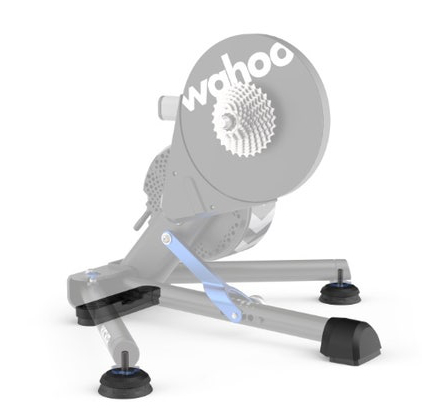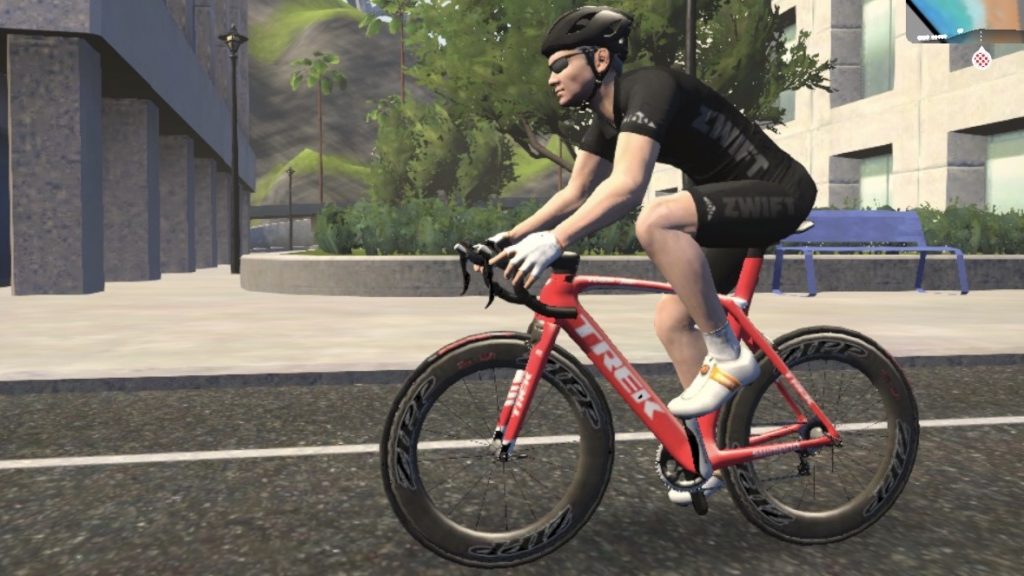(Originally posted June 18, 2023, with updates at the end)
If you own the Wahoo Kickr bike, you already have handlebar-mounted buttons for things like using power-ups, turning left and right, making u-turns, etc., so you might be wondering how much value there might be to adding the new Zwift Play controllers to your system. Well, I did, by rationalizing the $99 introductory price as a pretty small upgrade after the $3000+ cost of the bike. (Another victory for mental accounting!) Anyway, here’s one user’s story:
The Zwift play controllers are two controllers which attach to your handlebars and provide gaming console-like buttons (the classic up-down-left-right and “A-B-Z-Y”, because if your company name starts with Z you need a Z button more than you need an X button) as well as broad paddles you can push or pull. So, it’s eight buttons (that can differentiate between press and long-press) and two two-way paddles to add to the various buttons already on the Zwift bike’s handlebars.
Installing the Zwift Play paddles on a Wahoo Kickr Bike
Installation could not have been easier. They go on just like in the video, no spacers needed. And the fit is snug, too… on my bike at least there was less deflection in the controllers when pushing a button (though maybe I just have a softer touch than the person in the video). They do a pretty good job of keeping out of the way, though you should consider your grip. Riding on the hoods is fine but sometimes I put my hands just behind the hoods, and it is just a little harder to get my thumbs out of the way when I do. I think I’ll adjust, it’s not enough of an annoyance to be a deal-breaker.
Zwift Play quality of workmanship
The Zwift Play controllers seem nice. The have good heft to them and it doesn’t seem like they’re prone to break down soon. The buttons do seem a bit stiff for my taste. They look like X-Box buttons, but they don’t have nearly as good a feel. This is probably due to the rubber membrane that sits over the buttons, and since I’m a lot more likely to sweat on my Zwift Play controllers than I am my X-Box controller, I think it’s probably a good trade-off.
The Good
Having the Zwift Play controllers on my Wahoo Kickr bike eliminates just about every need I had to touch my iPad (or pick up my Apple Remote) during gameplay. Hitting the “up” button would call up the in-ride menu, and navigation from there was pretty easy using the left-right buttons to change options and the “A” and “B” buttons for OK and cancel, respectively. There are also a couple of actions such as returning a “ride-on!” which I was never able to do using the iPad or Zwift Companion interfaces.
Pulling either of the handlebar paddles in the outboard direction activates steering, and it does seem to me to be smoother than using the buttons on the Wahoo Kickr bike. Steering is still a feature I don’t use much in Zwift, but it works better now, and who knows? If enough people adopt the Zwift Play then the developers might integrate steering more into the game. Since steering by button or paddle is still the part of the bike interface that is the least analogous to its real-world counterpart it still feels like a weak link in the interface, despite being the best implementation of steering yet.
Pushing the handlebar paddles in the inboard direction activates braking, and this braking is different from how it’s implemented on the Wahoo Kickr bike. On the bike, using the physical brake handles, the braking mechanism slows the flywheel on the bike, but that doesn’t translate into braking in the game. Zwift doesn’t care how fast your flywheel is turning, just in how much power you’re applying to it. So coasting and braking (using the Kickr bike’s brakes) are the same thing.
The Zwift Play brakes, on the other hand, brake the in-game bicycle. This could be immensely useful for those time when you are dropping your pacebot, which I unfortunately seem to do at the top of a lot of hills).
If you’ve been using your computer as your Zwift interface, you probably could do all of this all along, but for people like me who have been playing on an iPad or an AppleTV, it’s like a brand-new feature!
(I also noticed during my first ride that Zwift finally did add the “teleport” option, which I have been extremely eager to have. It’s not related to the Play, as far as I know, but I was pretty stoked to see it)
The Bad
I can’t say that there’s anything I’d call “bad” about the new Zwift Play controllers. Using them does not preclude you from using the buttons on the Wahoo Kickr bike, so if you’d rather hit the bike’s button for a power-up, you still can. I’ve mentioned the stiff buttons and the slightly intrusive mounting, but these are not huge issues.
What’s Missing
What I really want is to be able to set my own commands for the Zwift Play buttons. There is some overlap between the Play and the Kickr bike, and by having both you have two buttons for power-ups, two for u-turns, and redundant controls for steering (though, as I mentioned above, the Play does it better). Let me re-map one of those buttons so I could quickly look behind myself to see who’s behind and catching up. That would be sweet.
Final Word
I am pretty excited about the Zwift Play. I didn’t have the effect on my Zwifting that getting moving from my bike-on-a-trainer to the Wahoo Kickr bike did, but then again it’s only $100. I hope that this will open the door to more users adopting it, because if a critical mass of Zwift riders have steering (and braking, for that matter), it would open the door for Zwift to making a bigger commitment to those features in the game. It’s great that Zwift can be played on many different setups, but it does mean that game development must necessarily be focused on the lowest common denominator. If the Zwift Play becomes part of people’s base setups, it will create opportunities for everyone.
Final, Final Word (update, May 2024)
Well, it’s about a year later, and I have to say that I’m not using the Zwift Play anymore. For my setup, it just didn’t add value. The Kickr Bike provides a lot of the same buttons (turning, power-up, etc) and I because I ride with the Zwift companion on my phone on my handlebars and because the iPad I use for display is within reach, there just isn’t much I can do with the Play that I can’t already do elsewhere. I think braking might be the only thing that the Play does that the Kickr Bike doesn’t (the Kickr Bike has brakes but they don’t affect the game — rather they affect the actual flywheel) but I can’t recall the last time I wanted to use my brakes in the game. Maybe something technical like Repack Ridge would benefit from it, but in my humble opinion that’s all still a gimmick. The Play’s turning controls are a little more to my liking than the Kickr Bike’s buttons, but that’s just not enough to make it worth it.
In the end, I found that the Play’s mounting position got a bit in the way when I was riding. In particular, when riding uphill it became a little bit of an annoyance figuring out where I could put my hands so that my fingers could grasp the handlebars comfortably.
I still think the Play is a nice bit of gear, and if I was still using my road-bike-on-a-trainer setup that I had before I moved to the Kickr Bike, I think it would be a terrific addition. Since so much of the functionality is duplicated on the Kickr Bike, though, in the end I just wouldn’t recommend it for those users.
























